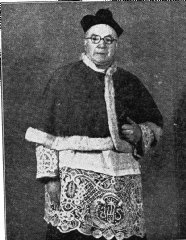
In the book, The Catholic Church in Modern Wales by Donald Attwater, it is claimed that it was Father Pozzi’s energy that enabled a church to be opened in Connah’s Quay in 1911.
Father Pozzi was a well-known figure and his priestly work was often reported in contemporary newspapers. In April 1910 the County Herald reported the tragic accident at Connah’s Quay when a Catholic child drowned. Father Pozzi presided over the funeral which was held in the Parish church at Hawarden.
When King Edward VII died in May 1910, Father Pozzi preached to Connah’s Quay Catholics. The County Herald published the services of all the churches and chapels in Connah’s Quay but unfortunately it did not say exactly where Father Pozzi preached to his Catholic congregation on that occasion. It did, however, record his words. ‘The Empire’, Father Pozzi said, ‘had been plunged into sorrow by the death of our good King Edward VII, a king who had won the love and esteem of his people, a king whose memory would ever be cherished by his Catholic subjects. We pray also for the Dowager Queen’.
A Growing Town.
The population of Connah’s Quay had been rising steadily since the mid nineteenth century. Its importance as a port and the growth of its industry had encouraged many people to settle in the area.
The diocese recognised the urgent need for a church for the increasing number of Catholics and help came directly from the leading Catholic family in the county, the Mostyns of Talacre. They had fostered one of the first Catholic communities to flourish at Talacre and had probably helped other Catholic parishes to grow throughout the diocese but they took direct action in Connah’s Quay. At this time a member of the Mostyn family, Francis, was also Bishop of Menevia and it was his sister Mary Louisa who took a particular interest in the plight of Connah’s Quay Catholics.
The Mostyns of Talacre.
In September 1909, Connah’s Quay UDC approved of plans to build a church on land opposite the Custom House. This land, according to the Valuation Rate book of 1910, was owned by Bishop Mostyn of Wrexham. The funding came from his sister who had come into her inheritance some years before.
The Mostyn estate had been tied into a settlement at the time of the marriage between Mary Louisa’s parents Sir Pyers Mostyn 8th Baronet and Frances Georgina Fraser. The terms of this agreement ensured an annual income for Lady Frances and on the death of her husband, a legacy for her children. In 1886 her two married daughters received £ 4,000 each and her spinster daughter Mary Louisa, £2,000. It is highly likely this was the money used by Mary Louisa to endow our church.
The Building of Connah’s Quay Catholic Church.
Thoughout the following year the newspapers gave regular progress reports on the new Catholic Church being built in Connah’s Quay.
County Herald, 12 August 1910: This church which is an imposing structure is rapidly approaching completion with a frontage to the main thoroughfare.
County Herald, 18 November 1910: The new Catholic Church which is near Wepre is approaching completion and the edifice will be opened in the course of a short time.
Before the church was completed, however, a building of a very different nature began to rise alongside it. Grandly called ‘The People’s Palace’ this was to become known as the Hippodrome theatre.
The Blessed Sacrament.
Eventually the new church opened and the Catholic Directory listed the Blessed Sacrament at Connah’s Quay (1911). Sunday Mass was at 9am and 10.30am. On Holy days of Obligation, Mass was at 8am. Weekday Mass was at 8am on Monday and Thursday. The first priest at Connah’s Quay was Rev. F.X. Thompson. Again the Mostyn influence may be seen at work here because Father Thompson’s previous church was at Talacre where he had served for five years.
A plaque in memory of the church’s founder is on the wall near the confessional. It reads:
PLEASE REMEMBER IN YOUR PRAYERS THE
DONOR OF THIS CHURCH & PRESBYTERY
MARY LOUISA MOSTYN
DAUGHTER OF SIR PYERS MOSTYN
8TH BARONET OF TALACRE
AND HON. FRANCES GEORGINA MOSTYN.
DIED 2ND APRIL 1933.
Sue Copp - June 2010